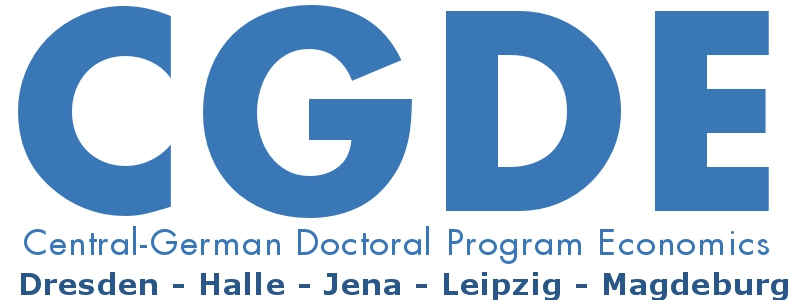Dynamic Macroeconomics & Inequality with Uninsurable Risk: Solution Methods and Applications to Models with Incomplete Markets and Heterogeneous Agents
Lecturer: Professor Dr Winfried Koeniger (Swiss Institute for Empirical Economic Research, University of St. Gallen)
Date: February 13-16, 2023
Venue: Halle Institute for Economic Research (IWH) – Member of the Leibniz Association, Kleine Maerkerstrasse 8, 06108 Halle (Saale), Germany, conference room (ground floor).
Registration: Please register for the course until January 31, 2023 by sending an e-mail to cgde@iwh-halle.de.
The course is designed for at most 15 participants. Places will be allocated on a first come, first served basis. Please also indicate the econometric software that you will have access to during the course.
Announcement: pdf
Prerequisites
A solid course in intermediate macroeconomics, e.g. based on the textbook Advanced Macroeconomics by David Romer.
Schedule
Monday, February 13
09:30-13:00 and 14:00-15:30
Tuesday, February 14
09:30-13:00 and 14:00-16:30
Wednesday, February 15
09:30-13:00 and 14:00-16:30
Thursday, February 16
09:30-13:00
Course Content
Many interesting problems that concern macroeconomics and inequality, in environments with uncertainty and shocks, have to be analyzed with dynamic and stochastic models of equilibrium. Unless one is willing to make very restrictive assumptions about the underlying environment, equilibria in these models need to be approximated numerically by dynamic programming.
This course introduces students to the numerical methods required for dynamic programming and applies these methods within the macroeconomic workhorse model with incomplete markets (uninsurable risk). This important model class allows to capture the distributional effects of fiscal and monetary policy across the population. In the applications, stylized facts on consumption, wealth and household debt are interpreted and analyzed within the model.
Qualification
The course will guide students towards the frontier of macroeconomic research which accounts for heterogeneous effects of fiscal or monetary policy. Students will learn the methods to perform policy analysis within this research field in their own research projects.
Methods
This course gives students the foundation to solve dynamic programs with value function iteration or the endogenous gridpoint method. In doing so, students learn about function approximation, numerical integration and numerical optimization.
Course Objectives
The goals of the course are
– to introduce students to the macroeconomic literature on incomplete markets,
– that students understand the methods to solve a dynamic program and
– that students are able to apply these methods to a problem of their interest.
The main learning outcomes are that
– students understand the macroeconomic workhorse model with incomplete markets,
– students are able to write code to solve that model,
– students are able to interpret the numerical output and
– students are able to evaluate economic policies within that model.
Course Literature
The following books or review articles give accessible introduction and background to some of the covered topics.
Bagliano, Fabio-Cesare and Giuseppe Bertola: Models for Dynamic Macroeconomics, Oxford University Press, 2004, chapter 1.
Bertola, Giuseppe, Richard Disney and Charles Grant: The Economics of Consumer Credit, MIT Press, 2006.
Davis, Morris: Macroeconomics, Cambridge University Press, 2009, chapter 3.
Deaton, Angus: Understanding Consumption, Oxford University Press, 1992.
Gollier, Christian: The Economics of Risk and Time, MIT Press, 2001.
Jappelli, Tullio and Luigi Pistaferri: The Economics of Consumption, Oxford University Press, 2017.
Kaplan, Greg and Giovanni L. Violante: The Marginal Propensity to Consume in Heterogeneous Agent Models, Annual Reviews of Economics, vol. 14, 747—775, 2022.
Krueger, Dirk, Kurt Mitman and Fabrizio Perri, Macroeconomics and Household Heterogeneity, Handbook of Macroeconomics, vol. 2A, chapter 11, Elsevier, 2016.
Piazzesi, Monika and Martin Schneider, Housing and Macroeconomics, Handbook of Macroeconomics, vol. 2B, chapter 19, Elsevier, 2016.
Below are further readings for each topic of the lecture:
1) Dynamic Programming
Bayer, Christian and Ralph Luetticke (2020): Solving Discrete Time Heterogenous Agent Models with Aggregate Risk and Many Idiosyncratic States by Perturbation, Quantitative Economics, vol. 11, 1253–1288.
Carroll, Christopher D. (2006): The Method of Endogenous Gridpoints for Solving Dynamic Stochastic Optimization Problems, Economics Letters, vol. 91, 312–320.
Clausen, Andrew and Carlo Strub (2016): A General and Intuitive Envelope Theorem, Manuscript, University of Edinburgh; revised version published as: “Reverse Calculus and Nested Optimization,” Journal of Economic Theory, vol. 187(C), 105019.
Druehdahl, Jeppe and Thomas Jorgensen (2017): A General Endogenous Grid Method for Multi-Dimensional Models with Non-Convexities and Constraints, Journal of Economic Dynamics & Control, issue 74, 87-107.
Hintermaier, Thomas and Winfried Koeniger (2010): The Method of Endogenous Gridpoints with Occasionally Binding Constraints among Endogenous Variables, Journal of Economic Dynamics & Control, vol. 34, 2074–2088.
Iskhakov, Fedor, Thomas H. Jorgensen, John Rust and Bertel Schjerning (2017): The Endogenous Grid Method for Discrete-Continuous Dynamic Choice Models with (or without) Taste Shocks, Quantitative Economics, vol. 8, 317-365.
Jang, Youngsoon and Soyoung Lee (2021): A Generalized Endogenous Grid Method for Models with the Option of Default, Bank of Canada, Staff Working Paper No. 2021-11.
Judd, Kenneth L. (1998): Numerical Methods in Economics, MIT Press, Cambridge, Massachusetts.
Ljungqvist, Lars and Thomas J. Sargent (2018): Recursive Macroeconomic Theory, MIT Press, Cambridge, Massachusetts.
Maliar, Lilia, Serguei Maliar and Pablo Winant (2019): “Will Artificial Intelligence Replace Computational Economists Any Time Soon?,” CEPR Discussion Paper No. 14024.
Rendahl, Pontus (2015): Inequality Constraints and Euler Equation Based Solution Methods, Economic Journal, vol. 125, 1110-1135.
Schmitt-Grohé, Stephanie and Martin Uribe (2004): Solving Dynamic General Equilibrium Models Using a Second-Order Approximation to the Policy Function, Journal of Economic Dynamics & Control, vol. 28, 755-775.
Stokey, Nancy L. and Robert E. Lucas (1989): Recursive Methods in Economic Dynamics. Harvard University Press, Cambridge, Massachusetts.
2) Application to Models with Exogenously Incomplete Markets
Aiyagari, S.Rao (1994): Uninsured Idiosyncratic Risk and Aggregate Savings, Quarterly Journal of Economics, vol.109, 659–684.
Attanasio, Orazio (1999): Consumption, Handbook of Macroeconomics, vol. 1B, chapter 11, 741–812.
Attanasio, Orazio and Steve Davis (1996): Relative Wage Movements and the Distribution of Consumption, Journal of Political Economy, vol. 1227–1262.
Attanasio, Orazio and Guglielmo Weber (2010): Consumption and Saving: Models of Intertemporal Allocation and their Implications for Public Policy, Journal of Economic Literature, vol. 48, 693–751.
Carroll, Christopher D. (1997): Buffer-Stock Saving and the Life Cycle/ Permanent Income Hypothesis, Quarterly Journal of Economics,
vol. 112, 1–55.
Deaton, Angus (1991): Saving and Liquidity Constraints, Econometrica, vol. 59, 1221–1248.
Fernández-Villaverde, Jesús and Dirk Krueger (2011): Consumption and Saving over the Life Cycle: How Important are Consumer Durables?, Macroeconomic Dynamics, vol. 15, 725–770.
Gourinchas, Pierre-Olivier and Jonathan A. Parker (2002): Consumption over the Life Cycle, Econometrica, vol. 70, 47–89.
2.1) Household Debt and Bankruptcy
Athreya, Kartik (2002): Welfare Implications of the Bankruptcy Reform Act of 1999, Journal of Monetary Economics, vol. 49, 1567–1595.
Chatterjee, Satyajit, Dean Corbae, Makoto Nakajima and José-Víctor Ríos-Rull (2007): A Quantitative Theory of Unsecured Credit with Risk of Default, Econometrica, vol. 75, 1525–1589.
Livshits, Igor, James MacGee and Michele Tertilt (2007): Consumer Bankruptcy: a Fresh Start, American Economic Review, vol. 97(1),
402–418.
Hintermaier, Thomas and Winfried Koeniger (2016): Debt Portfolios and Homestead Exemptions, American Economic Journal: Macroeconomics, vol. 8, 103-141.
Mitman, Kurt (2016): Macroeconomic Effects of Bankruptcy and Foreclosure Policies, American Economic Review, vol. 106(8), 2219-2255.
3) Endogenous Incomplete Markets
Ábrahám, Árpád and Nicola Pavoni (2005): The Efficient Allocation of Consumption under Moral Hazard and Hidden Access to the Credit Market, Journal of the European Economic Association, vol. 3, 370–381.
Ábrahám, Árpád, Sebastian Koehne and Nicola Pavoni (2011): On the First-Order Approach in Principal-Agent Models with Hidden Borrowing and Lending, Journal of Economic Theory, vol. 146, 1331–1361.
Bertola, Giuseppe and Winfried Koeniger (2015): Hidden Insurance in a Moral-Hazard Economy, Rand Journal of Economics, vol. 46,
777-790.
Broer, Tobias, Marek Kapicka and Paul Klein (2017): “Consumption Risk Sharing with Private Information and Limited Enforcement,” Review of Economic Dynamics, vol. 23, 170-190.
Cole, Harold, and Narayana Kocherlakota (2001): Efficient Allocations with Hidden Income and Hidden Storage, Review of Economic Studies, vol. 68, 523–542.
Golosov, Mikhail, and Aleh Tsyvinski (2007): Optimal Taxation with Endogenous Insurance Markets, Quarterly Journal of Economics,
vol. 122, 487–534.
Krueger, Dirk and Fabrizio Perri (2006): Does Income Inequality Lead to Consumption Inequality? Evidence and Theory, Review of Economic Studies, vol. 73, 163–193.
Pauly, Mark V. (1974): Overinsurance and Public Provision of Insurance: The Roles of Moral Hazard and Adverse Selection, Quarterly Journal of Economics, vol. 88, 44–62.
Rogerson, William P. (1985): Repeated Moral Hazard, Econometrica, vol. 53, 69–76.























